An Archivist’s Insight: Cinema Slides at George Eastman House
June 11, 2011
Paraphrasing Blanche DuBois: I have always depended upon the kindness of archivists. Today it my pleasure to introduce one of the kindest: Nancy Kauffman, archivist for the Stills, Posters and Paper Collections in the Motion Picture Department at George Eastman House. Since the very beginning of my research Nancy has been incredibly generous with her time, energy, and knowledge. Now as a guest contributor she is sharing again, this time providing her insider's perspective on the George Eastman House cinema slide collection.
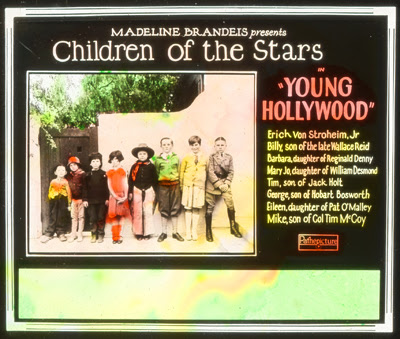
As an archivist, I’m often simply in reaction mode, rarely getting to choose what project or collection I work on. Don’t get me wrong – most everything I work on brings a smile to my face! There’s always organizing, re-housing, and cataloging that needs to be done with the materials in my vault, but how to choose which to process next? Fortunately, I can get tips and direction from the public, from researchers wanting to access our collections. This is what happened when Rob Byrne asked about our glass lantern slides.
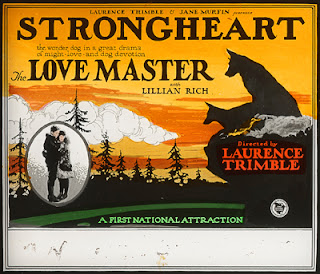
When Rob first contacted me asking if we had glass lantern slides – specifically “coming attraction slides” for movies – I was able to tell him, yes, we have glass lantern slides. I was able to generate an initial list of titles that already existed in a database. But as I looked at the list myself, I could see that more work was needed to better describe and define the slides. There was a mix of film titles, song titles, advertisements, and announcements. But which ones were which?
After giving Rob a preliminary list of titles, I started looking at the slides more closely. Gladly and willingly, I must add, as these items are really lovely and fun to look at. And the fix was fairly quick and easy. I looked at all the types of slides we seemed to have and expanded upon the field in our database that until that time described them only as “glass slide.”
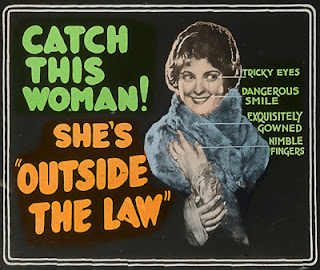
I simply increased the choices in that field to make the categories more specific:
- Glass slide - coming attraction
- Glass slide - song
- Glass slide - general announcement
- Glass slide - advertisemen
- Glass slide - subject
General announcement is for the “Ladies please remove your hats” type of slide.
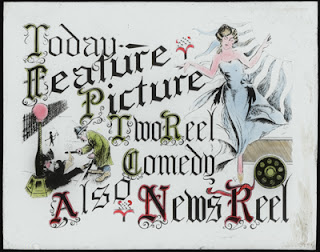
Advertisement is for local business advertisements (advertising for things other than films). And subject is sort of a catch-all for slides that were difficult to categorize within the context of our holdings of film-related materials – portraits of Abraham Lincoln and George Washington, botanical illustrations, and text documents to name a few. These types of slides appear to have been used as illustrations for educational lectures.
In looking at this collection, I found some interesting slides that are out of the norm of the typical coming attractions slides for Hollywood films. One group of slides I found that still needed to be processed (cataloged and re-housed at the item level) came from – of all places – the Wisconsin State Penitentiary.
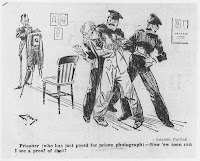
Although there are no slides in this collection for any specific film titles, there are some general announcement slides that clearly would have been used in the context of film screenings. The most interesting ones in this collection are the humorous slides that speak to the specialized audience of prisoners.
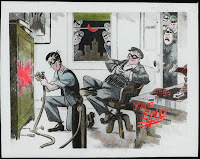
Four other slides stood out from the other coming attraction slides – these are for imported Czechoslovakian films shown in the U.S. As with the St. George and the Dragon slide from our collection that Rob previously wrote about here, these appear to have been aimed at immigrant audiences. Note that Bohemian titles are used as a selling point on one slide, and both Bohemian and English sub-titles on another.
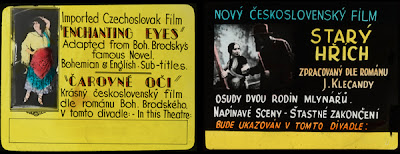
Most of the slides in the overall collection are in good condition, and of course the primary concern is breakage. We take the best steps we can to protect them, including housing them in individual sleeves or envelopes, in a file cabinet in a climate-controlled vault. The cardboard frames that many of the slides come in help tremendously in protecting the glass, and facilitate careful handling.
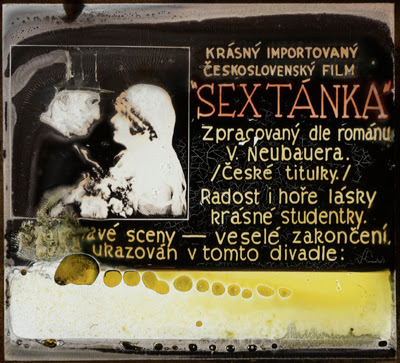
Others only have the taped edges around the glass, which make for more difficult handling and call for better protection. I have seen only one instance of decomposition, with one of the Czech film slides. I suspect this one was subjected to some very poor storage conditions before it came to us, or perhaps wasn’t constructed properly to begin with, making it much more susceptible to environmental factors.
This is just a sampling of some of the more unusual glass slides in our collection. I thought these would be interesting to share because, being outside the norm, they’re less likely to be seen otherwise. But I’d also like to share some samples of the more typical coming attractions slides, some of my favorites. I worked as a telephone operator when I was in college, so I really love the tag line on the slide for Daughters of the Night!



As with most collections, there is much more to know and understand from them than one usually sees at first glance. I give the highest priority to the requests I receive from the public, as these are real people wanting to access and use our collections out in the real world, and often in ways that I could never imagine or anticipate. In addition to helping me prioritize what to work on next, these requests often trigger a little more processing, cataloging, and simply learning about a particular collection that I otherwise may not have put at the top of my to-do list.
-- NANCY KAUFFMAN
Nancy Kauffman is the archivist for the Stills, Posters and Paper Collections in the Motion Picture Department at George Eastman House in Rochester, New York. The collections in her care exceed 3 million objects including stills, lobby cards, posters, press books, music cue sheets and scores for silent films, scripts, pre-cinema artifacts, and manuscript collections.
All slide images courtesy George Eastman House
